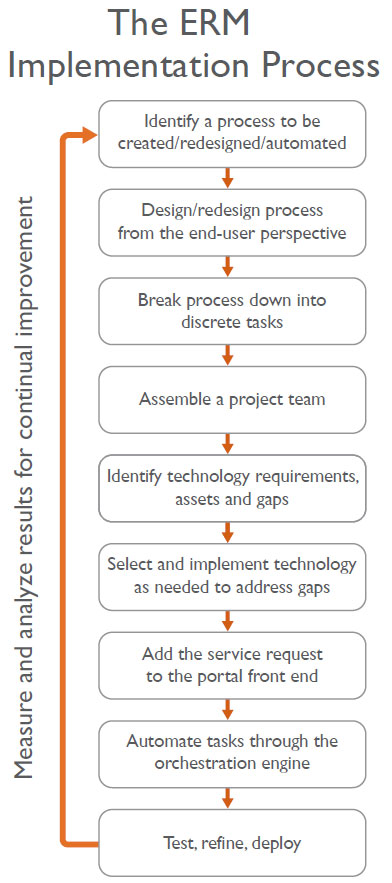Enterprise Request Management (ERM) is a business-efficiency strategy focused on centralizing and automating business processes and service requests. ERM helps to ensure first-time fulfillment, which means lower costs and happier customers.
Though the word “enterprise” sometimes conjures visions of huge, nightmarish implementations, ERM isn’t scary. Because it’s based on an agile approach, there’s no need for an ERM implementation to be excessively difficult, expensive, time-consuming, or disruptive to operations. It can be implemented incrementally by starting with one or a few processes, and gradually expanded across departments and functions as the concept proves its value.
 ERM leverages existing departmental and enterprise management and control applications, so additional technology and training investment requirements are often modest. The use of task automation and orchestration software eliminates the cost and risk of modifying core legacy application code. And enabling process owners (e.g., department managers) to map their own business processes using graphic tools both increases the sense of ownership across functions and minimizes the workload for IT.
ERM leverages existing departmental and enterprise management and control applications, so additional technology and training investment requirements are often modest. The use of task automation and orchestration software eliminates the cost and risk of modifying core legacy application code. And enabling process owners (e.g., department managers) to map their own business processes using graphic tools both increases the sense of ownership across functions and minimizes the workload for IT.
A new white paper from Kinetic Data defines the ERM concept and benefits, describes how to begin implementing an ERM strategy, and provides concrete steps to guide you through the implementation process.
An ERM implementation starts with identifying one or a few request management processes that are especially painful to users and the business itself, then assembling a small, informal project team consisting of a business analyst, a developer, the “owner” of the process, a representative from management, and, most importantly, users themselves, who can articulate the desired outcome in their own terms.
Next, those processes are broken down into discrete tasks. Manual processes are automated wherever feasible, to save time, reduce costs, and improve accuracy. Along the way, tasks and processes are tested, tweaked, refined, deployed, measured, and continually improved.
Download the new white paper, Enterprise Request Management: How to Get Started, to get the full (not scary) story about deploying ERM.
